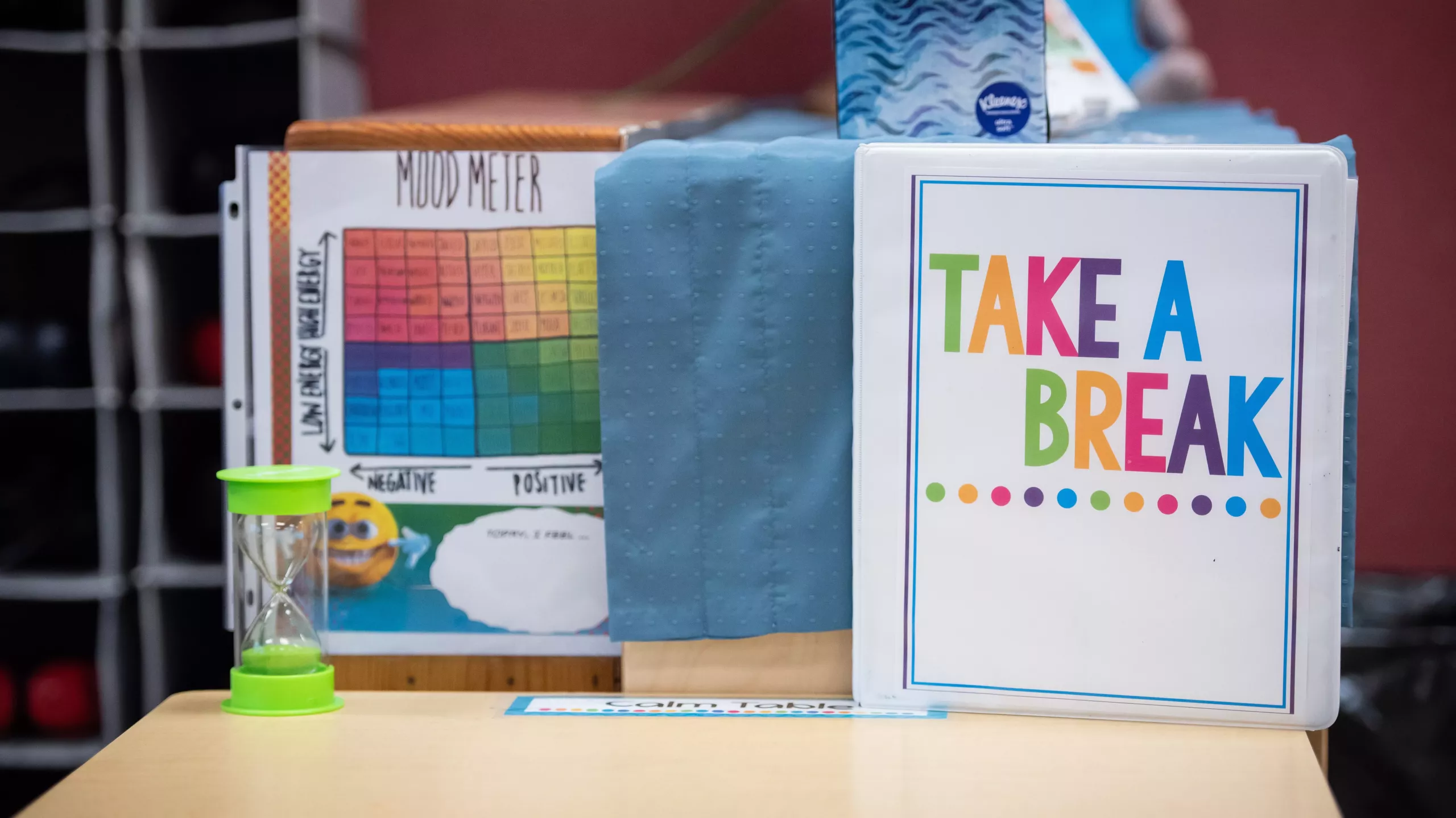Create A Calm Down Space
Imagine for a second that you had a place where you could reliably go to find as sense of calm and focus. That would be pretty useful, wouldn’t it?
That is the basic idea behind the calm down corner a.k.a. calm down space, calm down area, calm down zone. You and your class can decide what you want to call your space.

Calm down corners are an incredibly useful part of the FocusedKids method. They are also extremely effective in all grade levels. They give students a place to intentionally use the self-regulation skills they are learning and practicing with you. They also function as a positive behavior strategy.
Your calm down corner should be a relatively quiet part of your classroom where your class’s calm down kit lives. The calm down kit can house the self-regulation tools discussed in the previous lesson (i.e., the chime, breathing ball, glitter jar).
What To Include in a Calm Down Corner
Here are some of the things we recommend including in your calm down corner and kit.
- Calm Down Area Label
- Calm Down Basket with tools for calming
- Finding My Calm Chart (English PDF, Spanish PDF)
- I Feel Coloring Page
- I Feel Chart (English PDF, Spanish PDF)
- Social Story Books
- Calming Strategies Cards or Posters
- A Visual Timer (e.g. hourglass)
- A Breathing Chart
Calm down corners work especially well in preschool and elementary classrooms. However, at this age, children do require explicit instructions that support successful mastery of self-regulation skills. Below are some helpful suggestions.
How to Guide Use of Calm Down Corners
- Define the Space– The first step to setting up a calm down corner in your classroom is to define the space by labeling the area. The exclusive use for this area can only be accessed/used as a calm down space. There is no other reason a child should be there. It is a clearly defined space in your classroom that is conducive to being calm.
Then, answer these questions for how a student accesses the clam down area. Does the student use a visual indication? Do they access the space independently? Do they verbally request the use? Different students may access the area in different ways. But being very clear and consistent is the way it is done. As you are defining the space, also define the way that students will access it. - Calming Techniques – Choose the calm down techniques and tools that students will use while in the space. You may decide that you want sensory items, reflection tools, or guides to physical techniques to calm the body. Books and coloring sheets are other great tools. Know that children will choose different tools depending on their preferences and needs. So it helps to collaborate with them when choosing the tools for the corner.
It is really important to practice with all the tools and strategies as a class before putting them in the calm down corner for independent use. We recommend practicing as for at least one week as a class before giving students access to the calm down area. - Calm Down Rules – Remember, the calm down area isn’t a life sentence or an eternal trip to Neverland. Clear guidelines need to be established for how long a student is allowed to stay in the area and also how they get out. What are ways a student knows when they are calm?
Adding a visual to assess how the student is feeling becomes essential in a calm down area. Not only does it support students as they are developing an understanding of their emotions, but it also allows you to model the emotional state necessary to return to class. - Learning to Calm Down – An effective calm down corner includes some kind of learning moment. Tools that help them to become more aware of their emotions as well as what triggers certain feelings and then how to deal with them appropriately are critical. Otherwise, if a student is just bouncing in and out of the calm down area with no learning included, you’re ultimately not setting them up for longterm success.
- Learn to swim before diving in! – If a student who is in the middle of a behavior requires using the calm down corner, that’s the worst time to teach them how to use it. FocusedKids recommends routine instruction during circle time, several times a day to start, while they are in a calm state.
This includes directions on how to use the techniques and tools in the calm down corner as well as how to access the area. Pre-teaching these skills is the make-or-break for an effective calm down corner in the classroom.
By encouraging the use of the calm down corner, you’re encouraging students to take their self-regulation into their own hands. A skill that will set them up for a successful life.
